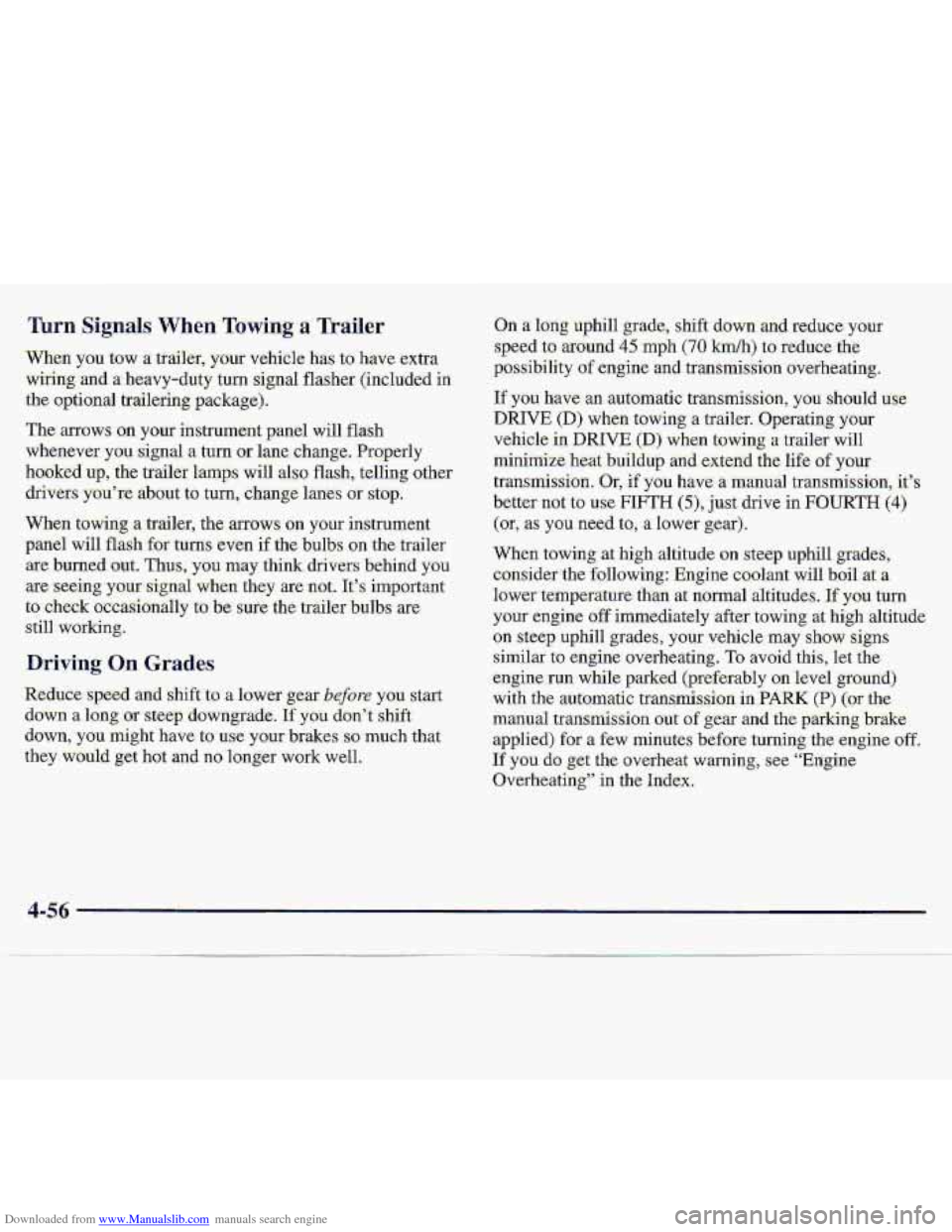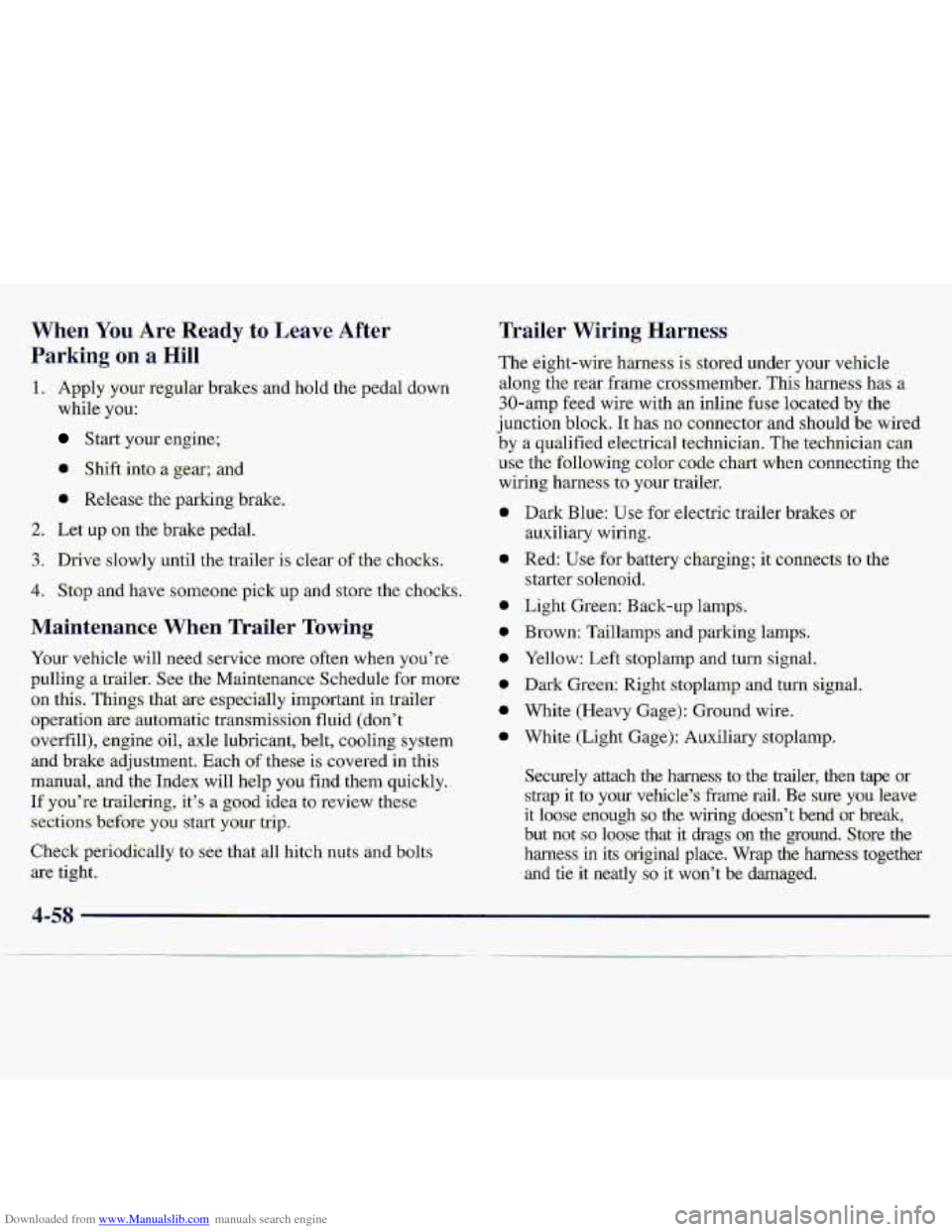Page 6 of 402
Downloaded from www.Manualslib.com manuals search engine L
Vehkle .Symbols.
These are sa-me of the s,ymbols you may find on your vehicle.
For-example,
these symbols
are used :on an
original battery:
PROTECT EYES
BY
SHIELDING
CAUSTIC
BURNS
SPARK OR ,111,
COULD FLAME
EXPLODE
BATTERY
These- symbols
:are important
for you and
yo,ur passengers
whenever your
vehicle is
driven:
DOOR LOCK
UNLOCK
FASTEN
SEAT
'BELTS
POWER
WINDOW
These symbols
have to do. with
your iamps.:
LlGmmI ING
.SIGNALS.
6 e3
TURN
WARNING A
HAZARD
FLASHER
FOG LAMPS
$0
These symbols
are on some Qf
your daritroh:
WINDSHIELD WIPER
WINDSHIELD
WINDSHIELD 'DEFROSTER
WiNDOW
DEFOGGER
These symbols
are used oil
warning and
indicator lights:
-BATTERY
CHARGING
SYSTEM
BRAKE (@)
ENGINE OIL w,
PRESSURE
Here are so.me
dther symbols
you may see:
FUSE -%F
I
LIGHTER
HORN
ttT
,SPEAKER
b
FUEL. p3
ANTI-LOCK (@)
BRAKES
V
.."
Page 109 of 402
Downloaded from www.Manualslib.com manuals search engine The oil pressure gage shows
the -engine oil pressure in
psi (poutlds pet square inch)
when theen@ne is running.
b CAUTION
Don't Keep driving if the oil pressure is.Iow.'If
yowdo, your engine can become sa, hot that it
catc-hes fire.-You or others could be burmd. ..
Che-ck your oil as soon as possible and have your
vehicle serviced.
I NOTICE:
Damage to your engine from neglected oil
probkms.can
be- costly and is. not covered by'
your warranty.
Page 110 of 402
Downloaded from www.Manualslib.com manuals search engine Shift Light Check Gages Light.
SHIFT
You have the SHIFT light
if you have a manual
transmission. This light
comes- on very briefly as a
bulb check wh-en
you start
the engine. Shifting when
the indicator light is on will
help
you get the best fuel
economy. See “Shift Light”
in the Index.
Daytime Running Lamps Indicator Light
This light is ,on the
instrument panel. It goes on
whenever the
DIU are on,
the ignition is on, the
headlamp switch
is off
and the parking brake-
:::(-)
.ma is released.
CHECK
GAGES
The CHECK GAGES light
will come
on briefly when
y9u
are starting the engine.
If the light comes on and stays on while you are driving,
check
your coolant temperature and engine oil pressure
gages
to see if they are in the warning zones.
2-63
Page 165 of 402

Downloaded from www.Manualslib.com manuals search engine Driving in Water
Light rain causes no specialaff-road driving problems.
But .ke.avy rain
can .mean flash flooding, and flood
waters demand extreme caution.
+Find- out how deep the water is before you drive through
it. If it’s deep enough to cover your wheel hubs, axles or
exhaust pipe, don’t
‘try it -- you probably won’t g-et
through. Also, water that deep
can damage your axle
and
other vehicle parts.
If the water isn’t too deep, then drive through it slowly.
At fast speeds, water splashes on your ignition system
and your vehicle
can st-dl. Stalling.can also occur if you
get your tailpipe under water. And, as long as your
:.. . tailpipe is ,under water, .you’ll never be able to start your
..;;&I
engine. When you gp through water, remember that
--.
. ,. , when your brakes get wet; it may take you longer
to stop. -‘a:i <,..,..?, ,
Driving through rushing water can be dangerous.
Deep water can
sweep your vehicle downstream
and you
and your passengers could drown. If it’s
only shallow water,
it can still wash away the
ground
from under your tires, and you could lose
traction and roIl the vehicle over.
Don’t drive
through
rushing water.
See “Driving Throagh Water” in the Index f6TmGE
infoination on driving through water,
4-28
Page 193 of 402

Downloaded from www.Manualslib.com manuals search engine When. you tow a tixiilkr, y-our vehicle ha.s to’have extra
wiring :and a- heavy-duty turn signal flasher. (included in
the- optional trailering package).
The arrows-on your instrument panel will flash
whenever.
you signal a turn 01- 1-me. change, Properly
hooked .up, the &&la lamps will also flash, telling other
drivers you’re
about to :turn, change lanes or stop.
When towing a:txailer,
the. arrows. on your hstrument
panel will flash for turm even if the bulbs on the trailer
are burned out. Thus, you may think drivers behind you
axe seeing your signal when they arenot. ICs important
to check. occasionally to.be sure- the trider bulbs are.
still working.
Driving On .Grades
Reduce speed and shiftlo dower. ge.ar. ,befure you start
dawn B long -or steep downgrade. If-you do-n’t shift
down,
you might have to use your brakes wmuch that
they would
get hot and no longer work weIl.
If you have an.aut~~atic-transm~ssion, you should use
DRIVE (D) when towing a trailer. Operating your
vehicle in DRIVE @) when towing a. trail& will
Mze: heat:buiidup and merid the life af y.our
transmissioil. Qr, if you have, a-manu-ai transmission,
it’s
better not to use FIFTH (S), just drive in FOURTH (4)
(or, as you need to, a lower gew).
4-56
Page 195 of 402

Downloaded from www.Manualslib.com manuals search engine When You Are Re.ady .to Leave After
Parking on a Hill
1. Apply your regular brakes and hold the pedal down
while you:
Start your engine;
s.hift; int,o a.gear; and
.i Release tfie parking brake.
2. Let up dn the brake pedal.
3. .Drive slowly until the trailer- is ele-ar of-the chocks.
4. .Stop. and have someone pick up and store the chocks,
Maintenance W-hen Trailer Towing
Your vehicle will need service more. often when you're
-pullilig'.a trailer. Swthe Maintenance Schedule 'for more
on this. Things. that ar.e e.specizrlly import,at in trailer
operation
-axe automatic trmsrnission.fluid (don't
overfill),
engjne oil, axle lubricant, belt, cooling system
and brake adjustment.
Each of these is covered in this
manual, and the
Tndex- will help you find them. quickly.
If you're traileriqg, i-t's a go0.d i,dea to review these
sections before you start ,your trip ...
Check periodicailp t6 see-.th-at all hitch nuts and bolts
are -tight.
Trailer Wiring Harness,
'The -eight-wire harness is: stored under ysur vehicle
along the
rear frame crossmember. This hamess has a
30-amp feed wire with an inline fuse located by the
.junction block. It has no.cmnecttor .and should he. wired
by a qualified electrical technician. T.he .technician can
use the fullowing c~lor:c.ode chart when connecting the
-wiring harness IO yow trailer:
0
a
a
0
0
0
a
a
Page 207 of 402
Downloaded from www.Manualslib.com manuals search engine Front Towing;
Tow.Limits. -- 35 rnph (56 kmh), 50 miles (-8O-km)
lrehicles with fuur-whesl-drive with the electronic
-transfercase opth must use a towing dolly under the
mar whe& when towing from the fipnt.
NOTICE:
Do not tow with sling-type equipment or
fascia/fog lamp damage will occur. Use wheel-lift
or car-carrier equipment. Additional ramping
may be. fequiped for car-earrier equipment.
Uk
safety chains and wheel straps.
Towing a vehicle over rough surfaces could
damage
a vehicle. Damage can occur from
vehicle to
ground or vehicle to wheel-lift
equipment.
To help avoid damage, instan a
towing doIly and raise the vehicle until adequate
clearance is obtained between the-ground and/or
wheel-lift equipment.
Do
not attach winch cables or J-haoks to
suspension components. when using;car-carrier
eq-uipment. Always use
T-hooks inserted in
the
T-hook-slots.
Page 211 of 402
Downloaded from www.Manualslib.com manuals search engine When you decide it’s m€e to lift the, hood, here’s what
you’ll see: I
P-
CAUTION:
If your vehicle. has air conditioning, the auxiliary
electric
fan under the hood can start up .even
when the. engine is not running. and can injure
you. Keep hands, clothing and tools
away from
any underhood .electric
fan.
If the coolant inside the coolant recovery tank is boiling,
don’t do anything else u,ntil it cools down.
A, Ccrolant R-ecovery Tank
B. .Radiator Prmsure Cap
C . Engine .Fan
5-14